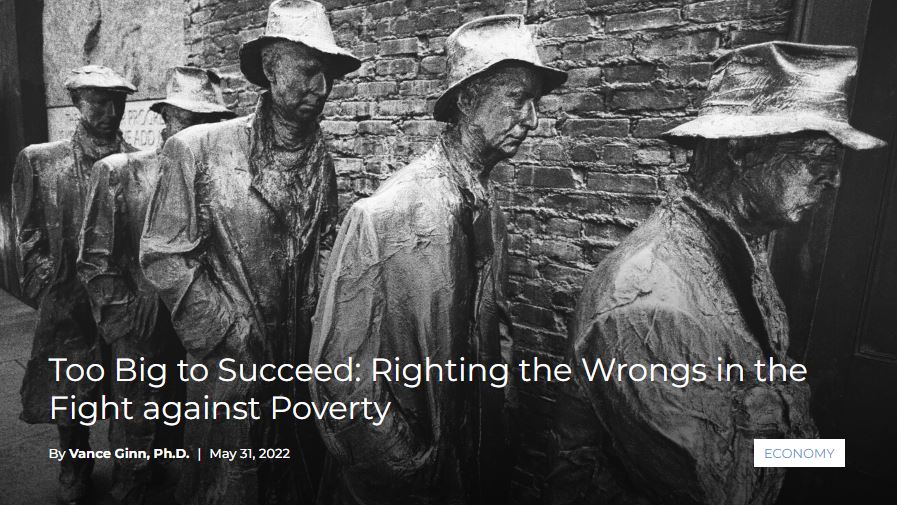|
When did it all start to go wrong? In the early 20th Century, Americans fighting poverty not only lost sight of the goal—lifting families up—but even of the problem itself, and instead sought to remake society through government intervention, often at the expense of the very people they were meant to help.
In 1920, Owen Lovejoy, president of the National Conference of Social Work, set a “new task” for the increasing number of social workers—they would become “social engineers,” who would create “a divine order on earth as it is in heaven.” As Marvin Olasky writes in his book, “Renewing American Compassion,” such a goal is far too lofty for individual acts of charity; “As some leaders forgot that compassion means suffering with, they looked more and more to government. They combined power seeking (for the good of others, of course) with social universalistic faith.” Who has time to worry about that man under the bridge when we’re remaking the world? This helps to explain failures in the war on poverty. Even setting aside the Great Depression and World War II, our most concentrated efforts have failed to move the needle on the official poverty rate. Nationally, about $25 trillion (adjusted for inflation) have been spent to combat poverty since 1964 when President Lyndon B. Johnson’s “war on poverty” engendered the Great Society. And the nation spends about $1 trillion per year on more than 80 federal safety-net programs. However, the country’s official poverty rate was declining before 1964, which was the primary measure available, but remained virtually unchanged between 10-15% since then, suggesting a failure of these redistributionist measures to substantially mitigate poverty. In addition to losing sight of the goal, we’ve lost sight of the problem itself—poverty. We haven’t done a good job of defining it, much less fixing it. To define the official poverty measure, the U.S. Census Bureau provides an estimated income threshold annually. When a family’s income falls below that threshold, they are considered to be in poverty, which the rate was 11.4% in 2020. There are flaws with this measure. So, if we merely look at it, we know a lot less about real poverty than we might think we do. While there are now better measures of poverty based on broader income levels or consumption, which tend to show much lower rates of poverty since 1964, these measures are focused primarily on material things rather than other important issues that influence poverty. What can we know about other issues related to poverty? We can look at statistical correlations and learn a lot. The strongest correlation we see with poverty is a job. Employment, in general, drives down poverty, irrespective of wages, although the effect is more pronounced with higher wages. The availability of jobs has a significant impact on poverty in both the present and a decade into the future. Education matters, as those with a high school diploma have a 24.7% poverty rate. Graduating high school is vital to help stay out of poverty. Demographics also matter. Perhaps the most powerful demographic structure, and the most powerful predictor of poverty in general, is single motherhood (25.6% poverty rate overall or 46.2% for those with children under 6 years old). Single motherhood is also a strong predictor of intergenerational poverty. Location matters; for example, there are 41 Texas counties within 100 miles of the U.S.-Mexican border that have been considered “persistently poor,” meaning at least 20% of the residents have been living in poverty for the last 40 years. Age is also a factor in poverty, but its impact varies depending on other group characteristics. Metro areas with a younger Black population have higher poverty rates, while areas with an older Black population have lower poverty rates. What does this tell us? It tells us where we can focus our efforts—and it’s not a one-size-fits-all approach. The path forward must consider these facts for increased opportunities for people to find financial self-sufficiency through a more holistic approach to poverty relief through an education, job, training, community, social capital, intact families with a mother and father, and other avenues provided by civil society whereby government provisions are available as a last resort. This follows much of what’s in the success sequence which is a formula of at least graduating high school, working full-time, and marrying before having kids (in that order) to have a 97% chance of not being in poverty. By connecting people to work, education, or training, enhancing community-based case management, streamlining safety-net programs, and getting resources to those who need it most, we can provide more opportunities for people to be self-sufficient. https://www.texaspolicy.com/too-big-to-succeed-righting-the-wrongs-in-the-fight-against-poverty/ Comments are closed.
|
Vance Ginn, Ph.D.
|


 RSS Feed
RSS Feed